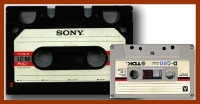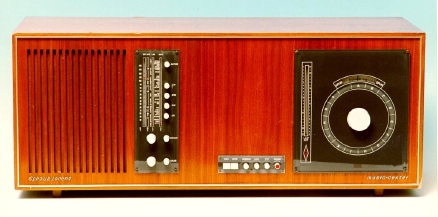
Obsolete recording formatsThe former type includes the wax cylinder, the familiar 78rpm gramophone record, the magnetic wire recorder, steel recording tape, and Philips-Miller optical film; with the LP record, open reel, and cassette tape hanging on by their fingernails. Some of the daft failed formats are quite entertaining. The main disadvantage of any gramophone record is that the linear speed past the needle reduces as the groove approaches the centre, with consequent reduction in quality. One invention attempted to deal with this by speeding the turntable up as the record progressed: a system which was unreliable, shortened the playing time, and required records which wouldn't play on any other type of gramophone. When the first experiments with published stereo took place in the early 1950s (as apart from the pre-war Bell and EMI experiments which were only within the laboratory) an early method was an LP record with two grooves - the left channel occupying the outside half of the record, and the right channel the inside half; and requiring a double arm and head to play it. It didn't catch on, and was rendered obsolete by the familiar both channels in one groove system.  The
Philips cassette of the early 1960s was a great success and is still used (a
little): but its quality was always limited. Sony made an interesting
miscalculation with their 1976 Elcaset, which used larger cassettes and wider
tape at a faster speed. It was beautifully engineered, but sank without trace -
ordinary punters were quite happy with the Philips cassette, and users concerned
with high quality turned to open reel recorders such as the
Revox. The
Philips cassette of the early 1960s was a great success and is still used (a
little): but its quality was always limited. Sony made an interesting
miscalculation with their 1976 Elcaset, which used larger cassettes and wider
tape at a faster speed. It was beautifully engineered, but sank without trace -
ordinary punters were quite happy with the Philips cassette, and users concerned
with high quality turned to open reel recorders such as the
Revox.But my favourite piece of nonsense was being sold off cheaply in the late 1960s; the Schaub-Lorenz Music Centre. 
This was built into a case about the size of a recording barometer, and looked a bit similar inside as it had four-inch wide tape on two vertical spindles. The tape moved slowly - probably 1 1/8 inches/second - and held 124 tracks running a maximum of 22 minutes. There was a recording/playback head which could be moved up and down to select a track. So you could record up to 124 22 minute pieces of music, and play any of them back - even moving from one piece to another in the middle (why would you do this?). At the end you still had to rewind. When you had filled up the 124 tracks, that was it: I have a feeling you couldn't even erase just one track, you had to erase the lot if you wanted to change anything. Not surprisingly, practically nobody bought it. Posted: Tue - January 6, 2009 at 09:17 AM by Roger Wilmut |
Quick Links
About Me:
Roger Wilmut XML/RSS Feed
MY PODCAST
Archives
Calendar
Blogroll
WEBRINGS
Statistics
Total entries in this category: Published On: Mar 11, 2016 05:00 PM |
||||||||||||||||||


